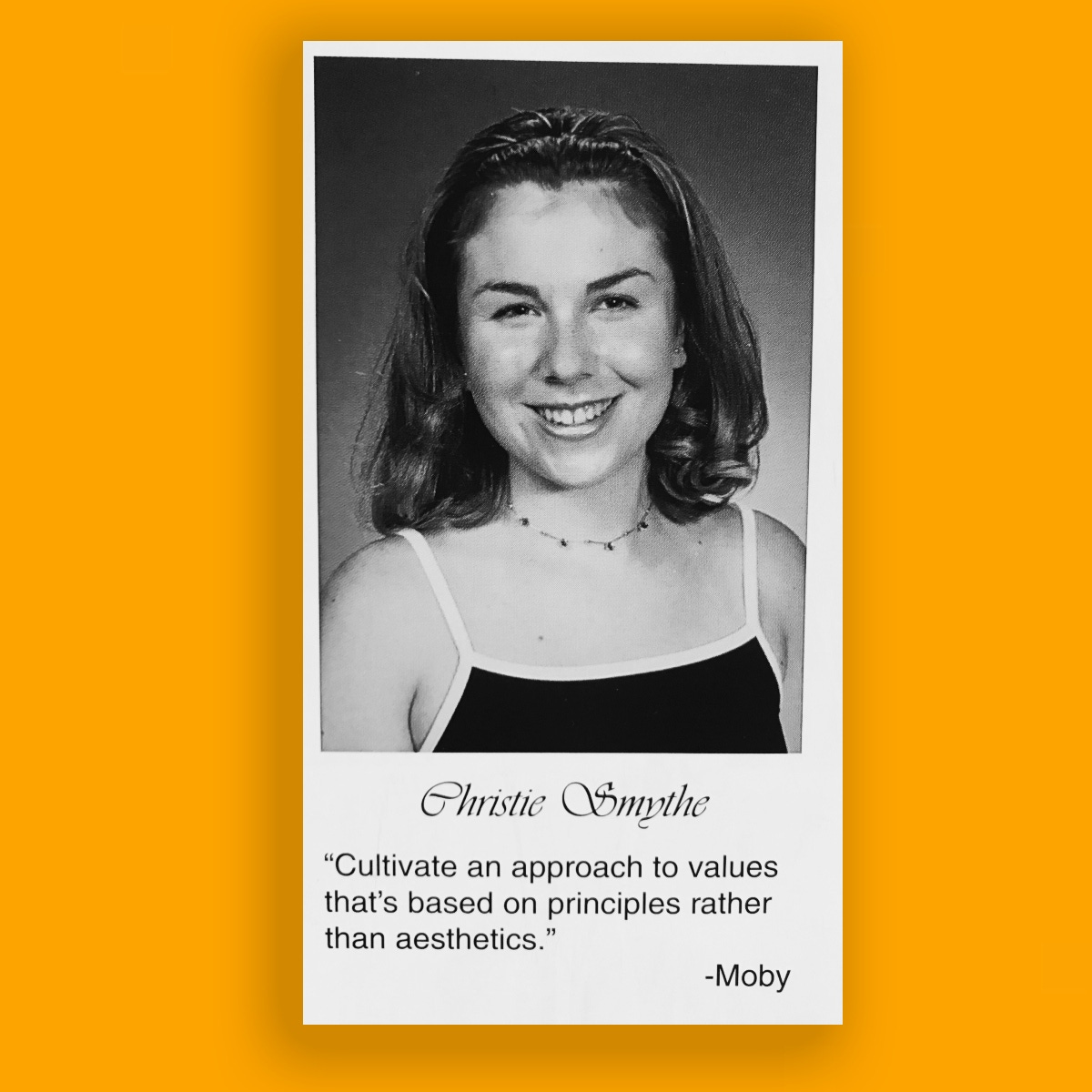It’s funny how formative experiences tend to repeat themselves. Being hauled into a Bloomberg HR meeting over my tweets about Martin Shkreli in 2018 didn’t feel that unfamiliar. A template for what the discussion was all about, what would likely be said and unsaid, and how management would try to “deal” with me was already imprinted in my mind — from way back when I was a freshman at St. Teresa’s Academy, an all-girls Catholic prep school in Kansas City, Missouri.
The issue then, 20 years earlier, was a photo I’d taken of two classmates (with their permission) for the local newspaper’s “teen” section. It was published alongside a story about how students at private schools expressed themselves through their appearances despite wearing uniforms. The two girls, who had their arms thrown happily around each other’s shoulders in the photo, were wearing St. Teresa’s signature tartan plaid skirts and white polo shirts…while also sporting hot pink dyed hair and eyebrow piercings.
“They’re…out of uniform!” the principal Mrs. Hoecker, a woman whom you might find on a Venn diagram at the intersection of “church lady” and “aging hippie,” said to me, as she tried to explain my “mistake.” Oddly, she wasn’t talking about the hair and the piercings. Instead she was referring to the girls’ untucked shirts. There were rules against untucked shirts, but no policies against students having pink hair and piercings — merely an unwritten rule against publicizing that fact, so I gathered.
As a skinny, quiet 15-year-old, who was among the top students in my class and not used to being in “trouble,” I found my vocal chords were all but paralyzed as I sat squarely within Mrs. Hoecker’s kind but disappointed gaze. I nodded compliantly along with her. But even though I could not muster the confidence to string together arguments, I still absorbed plenty of information from her that made me think: “Hey, wait a minute…”
Despite what she said, I didn’t believe that Mrs. Hocker’s real worry was the untucked shirts; I knew she was concerned about what the public, and especially wealthy donors, would think about students having pink hair and piercings. Curiously, she hadn’t admitted that concern to me. Instead she focused on a nominal policy violation, probably to convince me, an impressionable, meek-looking freshman, that I’d done something “wrong.”
I walked back to class that day mulling over the discomforting lesson I’d just learned. It was probably not the one Mrs. Hoecker had intended. I learned that institutions, even those which prided themselves on education, the pursuit of truth and “empowering young women to change the world,” as St. Teresa’s had claimed in its marketing materials, really cared most about their public image. A student publishing a photo in a local newspaper was an “empowering” achievement. I should have been congratulated for it. Instead I was shamed and intimidated.
If an educational institution would bully a 15-year-old girl just to protect its reputation, what else might other institutions do for similar reasons, I wondered. A shiver ran down my spine.
Déjà vu hit me when my editors and the Bloomberg HR rep wanted to talk to me about my tweets. It was early spring of 2018, around the time of Martin’s sentencing for securities fraud charges.
I had been trying to sell a book on Martin, who was also known worldwide as the “Pharma Bro” over his drug pricing tactics as a pharmaceutical company executive. But I hit a wall with publishers who were reluctant to “humanize” him. Meanwhile, my expertise on him and his case was going largely unrecognized in the public eye.
Many, many journalists tweeted LOTS of things about him and attracted ample attention for it. I wanted to assert my “territory,” so to speak. I decided, increasingly, to tweet about him as news came up and to share some of my thoughts and insights.
My emotions started to creep into my tweets, though. Watching Martin get thrown in jail, as the internet erupted gleefully into prison rape jokes, left my nerves frayed. A tweet where I’d tagged Lauren Duca, the journalist Martin had been kicked off of Twitter for harassing, after she threatened publicly to “cut off” his “organ,” likely crossed some lines. That, among some other tweets, undoubtedly irked the powers that be at Bloomberg, which staked its reputation on rigidly objective journalism.
Honestly, I was relieved when my editors and HR sprung the meeting on me. I had felt obligated to leverage my relationship with Martin in order to deliver “scoops” for Bloomberg, especially after I returned from the year of leave the company granted me for a fellowship at Columbia University. But as my friendship with Martin deepened, and I felt conflicted, I didn’t know how to raise the issue, or whom to raise it to, or what the solution might be. Bloomberg was highly siloed. Switching beats was likely off the table.
Just as I had sensed in my meeting with the principal over the photo in high school, the discussion at Bloomberg seemed pregnant with subtext. I had committed social media policy violations, they informed me — namely tweeting critiques of other journalists’ work and discussing some of Bloomberg’s editorial decisions. (Much like in the movie “Fight Club,” the first rule of working for Bloomberg is “don’t talk about Bloomberg,” as every employee knows.)
An editor assured me that my coverage wasn’t being questioned; they had done a review of my work and found no favoritism toward Martin. The HR rep asked me if I had experienced any “sexual harassment” he should know about. I shook my head, perplexed. Was he trying to give me some sort of an “out,” by accusing Martin of misbehavior, I wondered. “We know he has a strong personality,” one of the editors ventured, knowingly. I continued to stare in disbelief. “He has a strong personality?” I thought. “What am I, chopped liver?”
I told them I was glad for the discussion, and that I didn’t want to hurt the company, and then I willingly signed a form acknowledging my social media infractions. I happily consented to no longer covering Martin for Bloomberg, feeling some weight lift from my shoulders, and agreed not to violate social media policies again. After I walked out of the meeting room, though, the memory of Mrs. Hoecker and her strange preoccupation with untucked shirts in the newspaper photo prodded at me. What had this meeting really been about, I asked myself.
The nominal social media policy violations I’d acknowledged, much like the untucked shirts, were a cover story, I realized. They were a building block of a narrative, to cast me in the role of wrongdoer, if need be. “This is all confidential,” the HR representative had assured me in the meeting, but not for a single moment did I believe confidentiality was for my protection. My word, my reputation, and my financial interests could all be steamrolled by Bloomberg if it so chose.
I suspected the company would say whatever it wanted about me, or whatever it felt it needed to say to keep its standing in the public eye, if ever there were allegations of a “scandal” (a secret affair, for instance) involving me and Martin. Being a global news organization that valued truth and accuracy made no difference in that calculus, I realized. Principles did not matter to an institution as much as its image did. The larger and more respected the institution was, the more it valued its reputation.
A thought snapped across my brain like a stroke from a whip: I needed to look out for myself. Even though I had done nothing wrong, apart from minor social media policy violations, it would be easy enough for the company to insinuate all sorts of misdeeds if it wanted to. A few days after the meeting, I drafted an email to my editors:
“I wanted to put a couple of things on record in an email in case there are any whispered concerns floating around. Which is undoubtedly going to happen, I know, with this sort of thing. And one must figure out how to get these types of concerns out into the open a bit and deal with them, I feel.”
I continued:
“1. I do not have a romantic relationship with Martin Shkreli. I have not slept with him. He is not under the impression that we are dating. Despite his numerous awful jokes aimed at female reporters, he does have a very sophisticated sense of the ethical boundaries that would transgress. He respects me. He has made no attempt to cross that line. (And vice-versa.)”
“2. I have not accepted any payment or gifts from him other than a verbal promise of exclusivity for a book, and access to his family and friends. There were some modest drink and food purchases at times. We traded off with those bills or split the check. Currently, at least, I have no written contracts with him of any sort. That may change if a publisher or film producer decided I should get a legal release from him. But so far, nothing like that. I have received no monetary compensation, as of yet, for any materials gathered for my book, or any work I have produced with those materials.”
I added: “Sorry again for the grief.”
An editor replied quickly: “Christie - thanks for your email. (And you should know that we don’t have concerns 1. or 2.)”
I breathed a sigh of relief when I saw the email. At least I would have those words from my editor, like a talisman to ward away evil spirits, if the time came when someone tried to make me into a “scandal.” Maybe the underlying facts wouldn’t be so easy to sweep aside. And I whispered a short prayer of gratitude for the lesson I had learned from Mrs. Hoecker in Catholic school.
This post is dedicated to the memory of the late Mary Anne Hoecker, who was one of the kindest, warmest, most empathetic and service-driven people I have ever met — even if we disagreed sometimes about school uniform policies.














